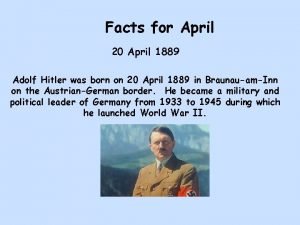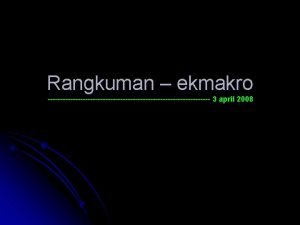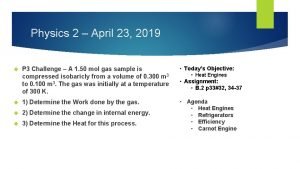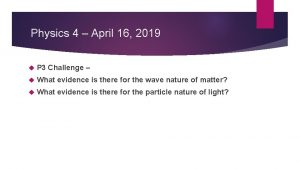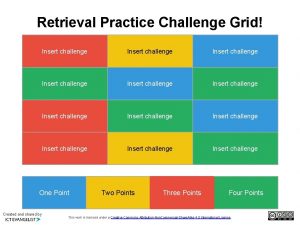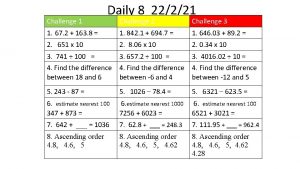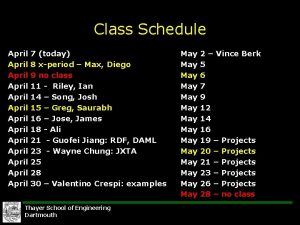Physics 2 April 11 2019 P 3 Challenge


















- Slides: 18

Physics 2 – April 11, 2019 P 3 Challenge – Check Exam Results Today’s B. 2. 1 -4 Objective: PV Work Assignment: B. 2 p 33 #18 -23 Agenda State Processes PV diagrams PV work derived

States In thermodynamics, the state of a system is defined by specifying values for a set of measurable properties sufficient to determine all other properties. For gases, these properties are P, V and T. E. g. Your health state could be said to be set by your vital signs. Simple gas law problems always involve two states. Ideal gas law applies to a single state. Processes involve at least two states.

State Functions A state function is any variable that is only dependent on the state of the system. A state function is not dependent on the path used to obtain the state. Many variables are state functions: mass, Energy, Entropy, Pressure, Temperature, Volume, chemical composition, density, number of moles Important variables that are NOT state functions: heat and work Both heat and work are path dependent

Types of Processes A thermodynamic process is one that takes a system from one state to another. There are several types of processes dependent on the conditions for the change. (We’ve already seen most with the simple gas laws. ) Isothermal process – Temperature is constant e. g. Boyle’s law Isobaric process – Pressure is constant e. g. Charles’ law Isovolumetric process – Volume is constant Adiabatic process – No heat transfer e. g. Gay-Lussac’s Law

PV Diagrams Pressure vs Volume graphs are the most common way to describe the state of an ideal gas and the processes it undergoes. Isobaric and isovolumetric processes are horizontal and vertical lines respectively. Isothermal processes are described by a strict inverse relationship. Recall Boyles law PV = constant when T is constant. The closer a line is to the origin, the lower the temperature.

Adiabatic Processes In an adiabatic process, Q = 0. From this, the relationship between P and V can be determined. The resulting equation means Its graph on a PV diagram will be similar to an isothermal line, but steeper. Problems similar to Bolye’s law problems can be solved using this equation if an adiabatic process is described. Ex: An ideal gas initially at 105 k. Pa expands adiabatically from 3. 5 x 10 -4 m 3 to 8. 9 x 10 -4 m 3. What is the new pressure?

Adiabatic Processes Notice that for an adiabatic process, P, V and T change. The initial and final states of an adiabatic process are located on different isothermal lines. Using the ideal gas law to find the VT relationship, solve PV = n. RT for P. Substituting this into the adiabatic equation and collecting all constant terms. (n, R and constant) If a gas expands adiabatically, the temperature drops. If a gas compresses adiabatically, the temperature rises.

PV Work (Big Takeaway conclusions)

Work Signs warning Why a detailed derivation? ? If you google PV work, half will say W = P V while the other half say W = – P V. IB text uses W = P V. We will see that this is just a convention and either is correct as long as you use a consistent first law of thermodynamics. One result is from the external perspective, one is from the internal gas perspective. Both are entirely correct, but which is being used is hardly ever stated. confusion for students.

PV Work Derived Part 1 – Work by Fext Work is defined as a force applied through a distance. Recall that work done on a system is positive. So its opposite, work done by a system, is negative. Picture an external force applied to a freely moving plunger in a cylinder on its side with a gas trapped. The work done by an external force for a compression will be positive and the work done by an external force for an expansion will be negative. The external force always points in the same direction which is defined as the positive x axis. Here, s is positive for compression and negative for expansion Fext s

PV Work Derived Part 2 – Piston h signs Consider the external force from the perspective of the gas by turning the cylinder vertically. Pick a height = 0 point as the initial piston location. For an expansion, the h of the gas sample is positive (h – 0) h=h h=0 For a compression, the h of the gas sample is h=-h negative (-h – 0) Notice that these signs for h are backwards from what we had for s.

PV Work Derived – Part 3 Work external Work external from gas’s perspective? Expansion, h positive Compression, h negative h=h h=0 s= – h h=-h Therefore Wext = – F h Wext, exp = – F h would be negative, Wext, comp = – F h would be positive. Workext for expansion is negative Workext for compression is positive

PV Work Derived – Part 4 Gas Pressure To transform our Wext expression into PV work, we first recognize that… the force exerted by the gas pressure is an equal and opposite reaction force to the external applied force. The gas pressure pushes out. The external force pushes in. Equal and opposite. W done by the gas is the opposite of the Wext

PV Work Derived – Part 5 Gas Pressure To convert force of gas into pressure and h into V, multiply by A/A as a form of 1. Sort the factors and replace by the definitions of P and V. Ta Da. That’s why the work done by a gas is called PV work. W for an expansion is positive and W for a compression is negative

PV work on a PV diagram P is the vertical axis and V is the horizontal, so P V corresponds to the area under the curve for a process. If the process is not isobaric, the PV work is still the area under the curve.

PV work on a PV diagram Sometimes this is easy to calculate, but for isothermals and adiabatic processes, it requires calculus. Area sweeps to the right are positive work ( V is positive) Area sweeps to the left are negative work ( V is negative)

Work done for a PV diagram cycle Many processes that are shown on a PV diagram are cycles that return the state of the system to the initial conditions. The energy change for a cycle is zero because energy is a state function. Work is not a state function. Work is the area within the loop created by the processes that make up the cycle. CW loop is pos. W. CCW loop is neg. W.

Exit Slip - Assignment Exit Slip- A gas expands isobarically from a volume of 3. 80 x 10 -3 m 3 to 5. 20 x 10 -3 m 3 at 103. 5 k. Pa. How much PV work is done by the gas? What’s Due? (Pending assignments to complete. ) B. 2 p 33 #18 -23 What’s Next? (How to prepare for the next day) Read B p 23 -32 about Thermodynamics
 Teen challenge nottingham
Teen challenge nottingham Valeo summer camp
Valeo summer camp Why does it happen
Why does it happen University physics with modern physics fifteenth edition
University physics with modern physics fifteenth edition Physics ia idea
Physics ia idea How to read p
How to read p April school activities
April school activities Spengel's travel agency
Spengel's travel agency April kindergarten newsletter
April kindergarten newsletter 20 april adolf
20 april adolf The morning night april
The morning night april 3 april 2008
3 april 2008 Cantebury tales prologue
Cantebury tales prologue 11. april
11. april Meaning
Meaning Wetter paris anfang juni
Wetter paris anfang juni Vårmåneder
Vårmåneder 2003 april 20
2003 april 20 11 april 2000
11 april 2000









